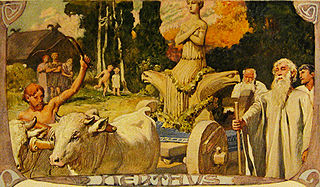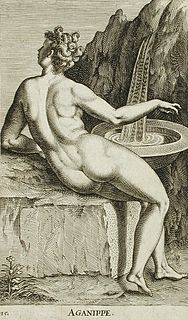Related Research Articles
In Greek mythology, Epione is the wife of Asclepius. Her name derives from the word ηπιος, and she was probably a personification of the care needed for recovery. With Asclepius, she had two sons, Machaon and Podalirius, who are mentioned in the Iliad of Homer. The Suda lists Aceso, Aglaea, Hygieia, Iaso, and Panacaea as her daughters.

Tsimshian mythology is the mythology of the Tsimshian, an Aboriginal people in Canada and a Native American tribe in the United States. The majority of Tsimshian people live in British Columbia, while others live in Alaska.
Seneca mythology refers to the mythology of the Seneca people, one of the six nations of the Iroquois Confederacy from the northeastern United States.
Mbuti (Bambuti) mythology is the mythology of the African Mbuti Pygmies of Congo.

Germanic mythology consists of the body of myths native to the Germanic peoples. The category includes Norse mythology, Anglo-Saxon mythology, and Continental Germanic mythology. It was a key element of Germanic paganism.
Rem, also Rem-Rem, Remi, or Remi the Weeper, who lives in Rem-Rem, the realm of weeping, was a fish god in Egypt who fertilized the land with his tears, producing both vegetation and the reptiles. He is assumed to be the personification of Ra's tears.
In Greek mythology, Hegemone was a Greek goddess of plants, specifically making them bloom and bear fruit. According to Pausanias, Hegemone was a name given by the Athenians to one of the Graces. Auxo represented the spring, and Hegemone autumn.
In Norse mythology, Norðri, Suðri, Austri and Vestri are four dwarves in the Prose Edda book Gylfaginning who each support one of the four cardinal points. Together, they uphold the heavenly dome, created from the skull of the jötunn Ymir. They probably represent the four winds, corresponding to the four stags of the cosmic tree Yggdrasil.
The cù-sìth(e), plural coin-shìth(e) is a mythological hound found in the folklore of Scotland. A similar creature exists in Irish folklore, and it also bears some resemblance to the Welsh Cŵn Annwn.

Kurdish mythology is the collective term for the beliefs and practices of the culturally, ethnically or linguistically related group of ancient peoples who inhabited the Kurdistan mountains of northwestern Zagros, northern Mesopotamia and southeastern Anatolia. This includes their Indo-European pagan religion prior to them converting to Islam or Christianity, as well the local myths, legends and folklore that they produced after becoming Muslims.
In Norse mythology, Glenr is the husband of the goddess Sól, who drives the horses of the sun across the sky.

Breton mythology is the mythology or corpus of explanatory and heroic tales originating in Brittany. The Bretons are the descendants of insular Britons who settled in Brittany from at least the third century. While the Britons were already Christianised in this era, the migrant population maintained an ancient Celtic mythos, similar to those of Wales and Cornwall.
In Norse mythology, Mögþrasir is a jötunn who is solely attested in stanza 49 of the poem Vafþrúðnismál from the Poetic Edda.
Bistonis is the name of a nymph in Greek mythology who gave birth to a son of Ares, Tereus. Although she is mentioned in several surviving classical texts, she is the main subject of few or none. In at least one poem, written by Moschus in the 3rd century BCE, Lake Bistonis, in Thrace, is referred to as being her lake, and that lake is described as having a population of nymphs:

Greek mythology is the body of myths originally told by the ancient Greeks, and a genre of Ancient Greek folklore. These stories concern the origin and nature of the world, the lives and activities of deities, heroes, and mythological creatures, and the origins and significance of the ancient Greeks' own cult and ritual practices. Modern scholars study the myths to shed light on the religious and political institutions of ancient Greece, and to better understand the nature of myth-making itself.

Norse mythology is the body of myths of the North Germanic peoples, stemming from Norse paganism and continuing after the Christianization of Scandinavia, and into the Scandinavian folklore of the modern period. The northernmost extension of Germanic mythology and stemming from Proto-Germanic folklore, Norse mythology consists of tales of various deities, beings, and heroes derived from numerous sources from both before and after the pagan period, including medieval manuscripts, archaeological representations, and folk tradition.
In Greek mythology, Eunostus or Eunostos was a goddess whose image was set up in mills, and who was believed to keep watch over the just weight of flour.
Mythology of Italy refers to the mythology of people living in Italy.

In Greek mythology, Aganippe was the name of both a spring and the Naiad associated with it. The spring is in Boeotia, near Thespiae, at the base of Mount Helicon, and was associated with the Muses who were sometimes called Aganippides. Drinking from her well, it was considered to be a source of poetic inspiration. The nymph is called a daughter of the river-god Permessus. Ovid associates Aganippe with Hippocrene.
References
- ↑ Sykes, Egerton; Kendall, Alan (2001). Who's Who in Non-Classical Mythology. Routledge. p. 103. ISBN 978-0-415-26040-4.